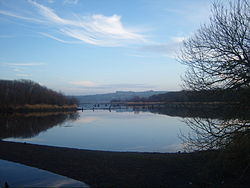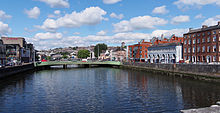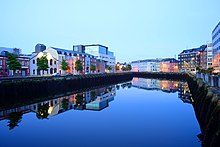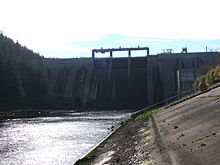For similarly-named rivers, see River Lee (disambiguation). Not to be confused with the River Lee that flows through Tralee.
| River Lee | |
|---|---|
 The Gearagh, a submerged woodland situated on the Lee near Macroom The Gearagh, a submerged woodland situated on the Lee near Macroom | |
 Map of the River Lee drainage basin Map of the River Lee drainage basin | |
| Native name | An Laoi (Irish) |
| Physical characteristics | |
| Source | |
| • location | Shehy Mountains near Gougane Barra |
| Mouth | |
| • location | Celtic Sea at Cork Harbour mouth |
| Length | 90 km (56 mi) |
| Basin size | 1,253.5 km (484.0 sq mi) |
| Discharge | |
| • average | 40.4 m/s (1,430 cu ft/s) |
| Basin features | |
| Tributaries | |
| • right | Curraheen River |
The River Lee (Irish: An Laoi) is a river in Ireland. It rises in the Shehy Mountains on the western border of County Cork and flows eastwards through Cork, where it splits in two for a short distance, creating an island on which Cork's city centre is built, then passes through Cork Harbour on the south coast, one of the largest natural harbours in the world, to empty into the Celtic Sea. The catchment area of the River Lee is 1,253 km. The long-term average flow rate of the River Lee is 40.4 cubic metres per second (m/s).
A hydro-electric scheme was built on the river, upstream from Cork City, and this part of the river now contains the Carrigadrohid and Inniscarra reservoirs. The river is crossed by 42 bridges, 29 of which are in Cork City, and one tunnel. The river also provides an 8-kilometre (5.0 mi) stretch of salmon fishing.
Name
Ptolemy's Geography (2nd century AD) described a river called Δαβρωνα (Dabrona) or Λαβρωνα (Labrona), which is sometimes considered to refer to the River Lee. Though unconfirmed, the Irish name for the river, Laoi, may derive from Corca Luighe, which in turn derives from 'Luighe', the son of a quasi-mythical Milesian noble.
There is also the Λουρ (Lour), a separate river which passes through Tralee.
Description
Sources
The River Lee has its source in the Shehy Mountains near Gougane Barra, where there is a forest park, chapel, hotel, and shop.
Course

The Lee flows from the lake of Gougane Barra as a fast-paced torrent, but by the town of Ballingeary it eases and flows into Lough Allua. Departing the lough, running east, it again becomes a rapid flow before running into The Gearagh, and Carrigadrohid feeder reservoirs, and then into the large Inniscarra reservoir created by Inniscarra Dam. Moving on, it flows down from the dam, in normal conditions a gentle river until it comes to Ballincollig Weir in Ballincollig Park; here it is dangerous to swimmers when in high water. The Lee then flows into the city under Inniscarra Bridge and flows parallel to the Carrigrohane road. Along this section gauges monitor the water levels from the Inniscarra Dam. The river flows over the Lee weir and then is split into the north and south channels at a sluice (it historically occupied the city area as a maze of channels). This area is popular for recreation, kayaking and fishing. The two channels join again at the Cork docks and enter the extensive estuary and harbour, south of Glanmire, passing either side of Great Island (Cobh lies on the south coast) to fill the outer harbour, and reaching the open sea between Whitegate and Crosshaven.
Tributaries
Upper course (above Inchigeela)
High tributaries include the Owenagariff, the Bunsheelin, the Paudeen and the Garrifowa.
Middle course (to the Dripsey)
Tributaries joining below Lough Allua and Inchigeela include the River Toon, the extensive Sullane River system, from near Ballyvourney (tributaries include the Douglas, Finnow, Foherish and Laney or Laine Rivers) via Macroom, the smaller Buinea and Glashagariff Rivers, and the River Dripsey and its tributaries the Rylane and the Delaghinagh.
Near Cork city
Below the last ESB dam, tributaries joining include the River Bride from Slievowen via Crookstown, Killumney and Ovens, and the River Shournagh (formed from the Blarney and Martin Rivers, and the Owennagearagh River; historically may have been the Awbeg River).
City area

City area tributaries include the combined Maglin (from Ballincollig) and Curraheen (occasionally Curragheen) Rivers, capturing the Glasheen River also and joining at the western end of the UCC complex, and the Kiln River (sometimes Bride River) which joins by the Christy Ring Bridge in the city centre, a little west of St. Patrick's Bridge (formed in turn from a Bride River and the Kilnap or Glennamought River, later joined by the Glen River).
Tidal area
Estuarine tributaries include the Glashaboy River, passing Glanmire (main tributaries the Black Brook, Cloghnageshee River and Butterstown River), the Douglas or Tramore River (joined by the Trabeg River as it flows into the Douglas Channel, its estuary) which drains parts of the southern city, Owennacurra River (joined by the Dungurney River at Midleton), and the Owenaboy River almost at the final mouth of the outer Lee estuary (the Liberty Stream joins this river, with significant flows from Cork Airport).
Recreation
Recreation activities on the Lee include sailing, swimming, kayaking, water skiing. Several rowing clubs are based on the Lee including the "Lee Rowing Club", "Shandon Boat Club" and “Cork Boat Club”. Naomhoga Chorcai is also based on the Marina, and is Ireland's largest Currach (traditional canvas fishing boat) rowing club. Angling is also common from the banks of the Lee Fields.
Flooding


Tidal considerations, combined with low-lying urban developments, and later dam management contribute to repeated flooding events on the Lee. Specific streets in Cork city centre have been affected by floods more than 100 times since the mid-19th century.
2009 flooding
In late 2009 the river flooded, causing some of the most significant damage in Cork city for a number of centuries. The Lee Water Station was forced to shut down after being submerged under six metres of water, and resulted in 40% of Cork City (50,000 people) being without running water for over a week. Lower-lying parts of the University College Cork campus were also flooded extensively, resulting in lectures being cancelled throughout the week. There was severe damage to the university's then newly built IT building, the Western Gateway Building, situated next to the river on a known floodplain, where, for example, a 300-seat auditorium was flooded to near ceiling height. To prevent issues upstream, the ESB made a controversial decision to release water from the Inniscarra hydro-electric dam. This released 535 tonnes of water per second into the already flooded river, raising the flood to 1.5 metres in parts of the city centre. The ESB insisted this was an essential move, and if water had not been released, the flooding would have been much worse.
See also
References
- ^ "Irishfisheries.com/waterways - River Lee". irishfisheries.com. Archived from the original on 17 November 2007.
- "Archived copy" (PDF). Archived from the original (PDF) on 3 March 2016. Retrieved 2 March 2015.
{{cite web}}: CS1 maint: archived copy as title (link) - "An Laoi/River Lee". Logainm.ie. Irish Placenames Commission. Retrieved 17 December 2019.
- ^ South Eastern River Basin District Management System (PDF). South Eastern River Basin District Report (Report). p. 38. Archived from the original (PDF) on 3 March 2016.
- ^ "Ireland" (PDF). Romaneranames.uk. Roman Era Names. Retrieved 1 January 2018.
- Kieran McCarthy (2017). Secret Cork. Amberley Publishing. ISBN 9781445667157.
The origin of the name Lee is sketchy and legend reputedly attributes the name to the Milesians named 'Corca Luighe' The River Lee has had many variations of spelling. In the Book of Lismore, it is described as Luae. It has also been written as Lua, Lai, Laoi and the Latin Luvius
- "River Lee Project". CorkHeritage.ie. Retrieved 1 January 2018.
- John Windele (1910). Cork: Historical and Descriptive Notices of the City of Cork from Its Foundation to the Middle of the 19th Century. Guy and Company. p. 3.
- ^ Milner, Liam (1975). The River Lee and Its Tributaries (1 ed.). Cork, Ireland: Tower Books.
- "Insurance Plan of Cork (Goad Map)" (PDF). 1897 – via corkpastandpresent.ie.
- Lee CFRAMS: Hydrology Report, Halcrow Group Ireland (Report). Cork: OPW. 2008.
- "Lee CFRAM Study Predictive Flood Maps". opw.ie. Office of Public Works.
- "Lee Catchment Flood Risk Assessment and Management Study". 8 May 2016. Archived from the original on 8 May 2016.
{{cite web}}: CS1 maint: bot: original URL status unknown (link) - Lee Catchment Flood Risk Assessment and Management Study - REP007 - Final Report (PDF). lee.cfram.com (Report). Halcrow Group Ireland. January 2014. Archived from the original (PDF) on 8 May 2016.
- "Lower Lee (Cork City) Flood Relief Scheme". lowerleefrs.ie. Archived from the original on 2 June 2016.
- "Flooding in Oliver Plunkett Street - Cork Past & Present". corkpastandpresent.ie. Cork City Libraries. Retrieved 17 December 2019.
- "City facing bill of €100m to fix flood damage". Irish Independent. 23 November 2009. Retrieved 27 January 2010. Independent.ie's summary on the flood
- "University College Cork (UCC): Weather Notifications". Archived from the original on 24 November 2009. Retrieved 27 January 2010. UCC's Notification webpage on the floods
- "Report-on-Major-Flood-Damage.pdf" (PDF). Retrieved 27 January 2010. PDF file on the damages
- Riegel, Ralph; Melia, Paul (8 December 2009). "ESB stands by decision to release water into city centre". Irish Independent. Archived from the original on 22 October 2012. Retrieved 27 January 2010.
External links
| Rivers of Ireland | |
|---|---|
| List | |
| Flowing north | |
| Flowing to the Irish Sea | |
| Flowing to the Celtic Sea | |
| Flowing to the Atlantic | |
| Tributaries of the Shannon | |
| River names in italics indicate rivers which are partially or wholly in Northern Ireland, with the rest being wholly in the Republic of Ireland | |
| Cork Harbour | |||||||
|---|---|---|---|---|---|---|---|
| Settlements |  | ||||||
| Harbour islands | |||||||
| Industry and economy | |||||||
| Navigation |
| ||||||
| Naval and military |
| ||||||
| See also: Coastal fortifications of County Cork | |||||||
51°53′55″N 8°32′21″W / 51.89861°N 8.53917°W / 51.89861; -8.53917
Categories: